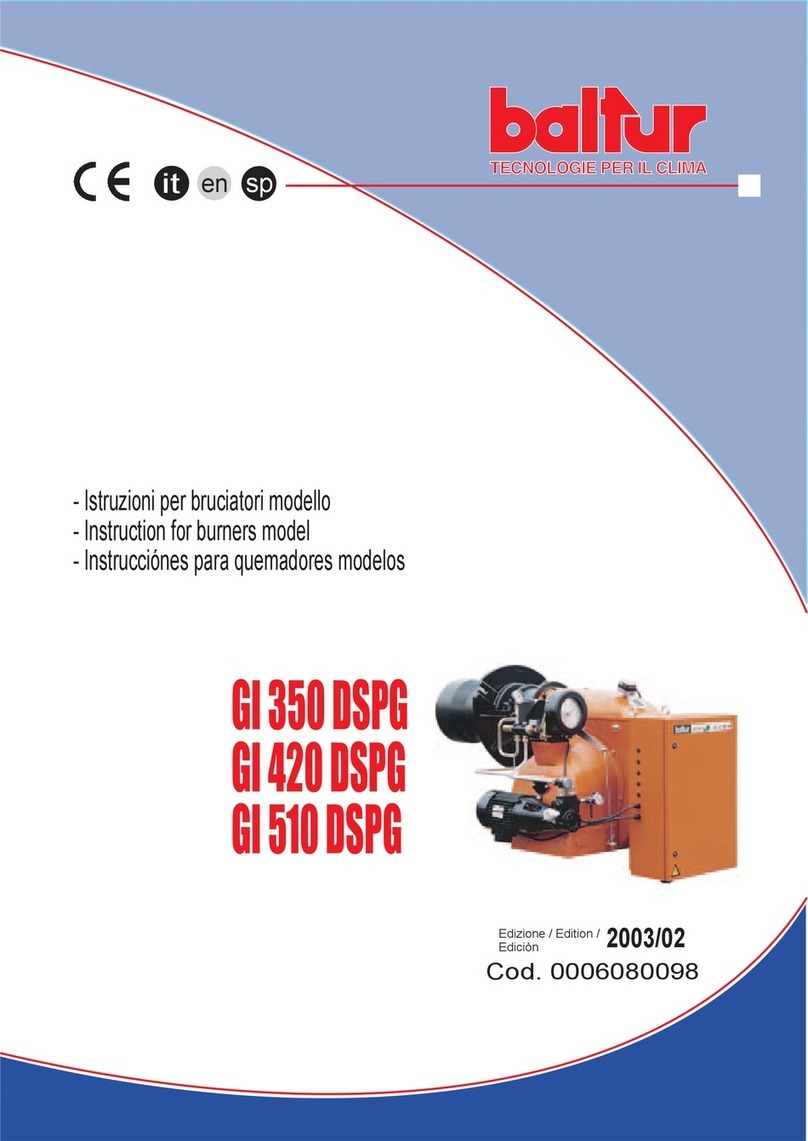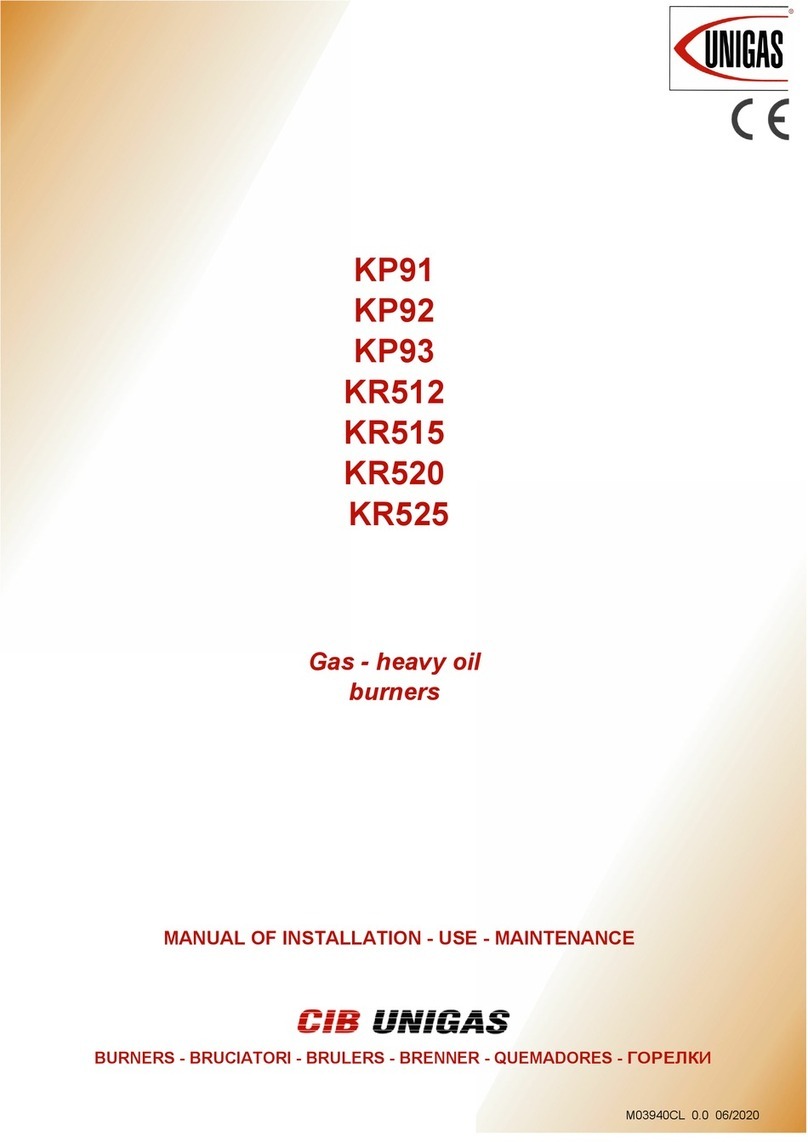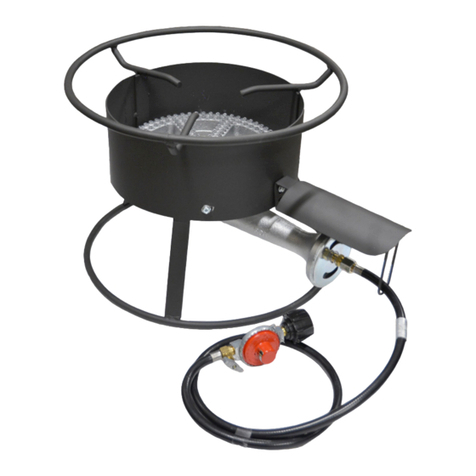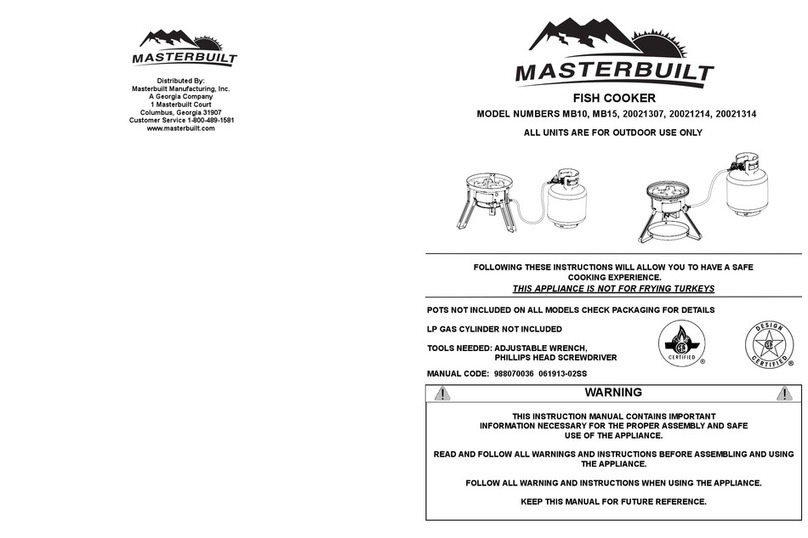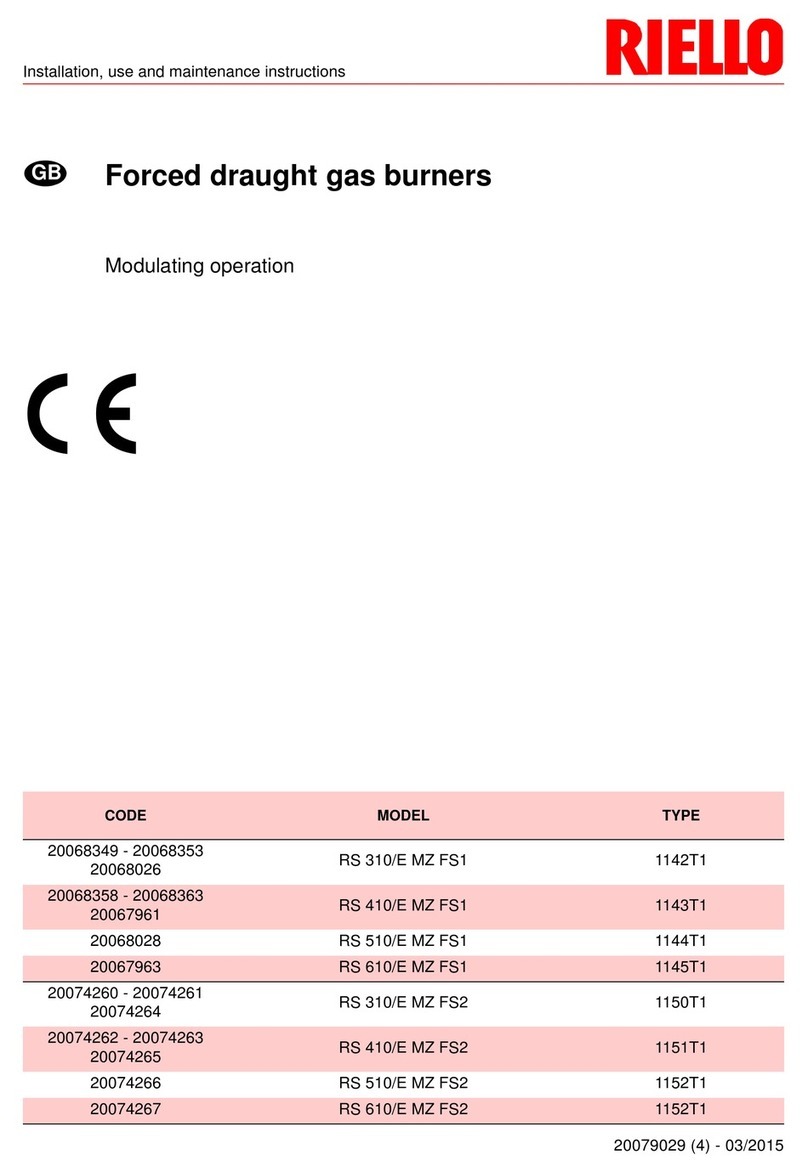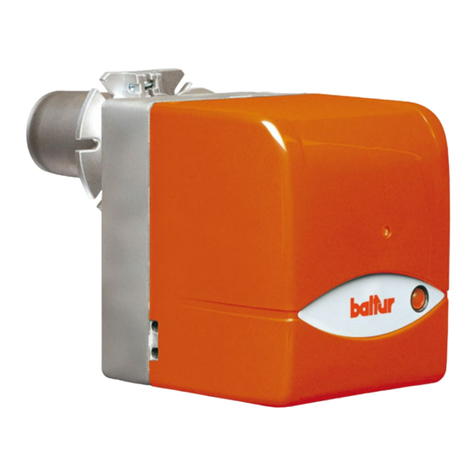Automatic Heating Enterprise NG 120 Installation and operating instructions


NOTICES2
NOTICES
THIS MANUAL IS SUPPLIED AS AN INTEGRAL AND ESSENTIAL PART OF THE PRODUCT AND MUST BE DELIVERED
TO THE USER.
INFORMATION INCLUDED IN THIS SECTION ARE DEDICATED BOTH TO THE USER AND TO PERSONNEL FOLLOWING
PRODUCT INSTALLATION AND MAINTENANCE.
THE USER WILL FIND FURTHER INFORMATION ABOUT OPERATING AND USE RESTRICTIONS, IN THE SECOND SEC-
TION OF THIS MANUAL. WE HIGHLY RECOMMEND TO READ IT.
CAREFULLY KEEP THIS MANUAL FOR FUTURE REFERENCE.
1) GENERAL INTRODUCTION
zThe equipment must be installed in compliance with the
regulations in force, following the manufacturer’s instruc-
tions, by qualified personnel.
zQualified personnel means those having technical knowle-
dge in the field of components for civil or industrial heating
systems, sanitary hot water generation and particularly ser-
vice centres authorised by the manufacturer.
zImproper installation may cause injury to people and ani-
mals, or damage to property, for which the manufacturer
cannot be held liable.
zRemove all packaging material and inspect the equipment
for integrity.
In case of any doubt, do not use the unit - contact the supplier.
The packaging materials (wooden crate, nails, fastening devi-
ces, plastic bags, foamed polystyrene, etc), should not be left
within the reach of children, as they may prove harmful.
zBefore any cleaning or servicing operation, disconnect the
unit from the mains by turning the master switch OFF, and/
or through the cut-out devices that are provided.
zMake sure that inlet or exhaust grilles are unobstructed.
zIn case of breakdown and/or defective unit operation,
disconnect the unit. Make no attempt to repair the unit or
take any direct action.
Contact qualified personnel only.
Units shall be repaired exclusively by a servicing centre, duly
authorised by the manufacturer, with original spare parts.
Failure to comply with the above instructions is likely to impair
the unit’s safety.
To ensure equipment efficiency and proper operation, it is
essential that maintenance operations are performed by quali-
fied personnel at regular intervals, following the manufactu-
rer’s instructions.
zWhen a decision is made to discontinue the use of the
equipment, those parts likely to constitute sources of dan-
ger shall be made harmless.
zIn case the equipment is to be sold or transferred to
another user, or in case the original user should move and
leave the unit behind, make sure that these instructions
accompany the equipment at all times so that they can be
consulted by the new owner and/or the installer.
zFor all the units that have been modified or have options fit-
ted then original accessory equipment only shall be used.
zThis unit shall be employed exclusively for the use for
which it is meant. Any other use shall be considered as
improper and, therefore, dangerous.
The manufacturer shall not be held liable, by agreement or
otherwise, for damages resulting from improper installation,
use and failure to comply with the instructions supplied by the
manufacturer.
2) SPECIAL INSTRUCTIONS FOR BURNERS
zThe burner should be installed in a suitable room, with ven-
tilation openings complying with the requirements of the
regulations in force, and sufficient for good combustion.
zOnly burners designed according to the regulations in force
should be used.
zThis burner should be employed exclusively for the use for
which it was designed.
zBefore connecting the burner, make sure that the unit
rating is the same as delivery mains (electricity, gas oil, or
other fuel).
zObserve caution with hot burner components. These are,
usually, near to the flame and the fuel pre-heating system,
they become hot during the unit operation and will remain
hot for some time after the burner has stopped.
When the decision is made to discontinue the use of the bur-
ner, the user shall have qualified personnel carry out the fol-
lowing operations:
a) Remove the power supply by disconnecting the power cord
from the mains.
b) Disconnect the fuel supply by means of the hand-operated
shut-off valve and remove the control handwheels from
their spindles.
Special warnings
zMake sure that the burner has, on installation, been firmly
secured to the appliance, so that the flame is generated
inside the appliance firebox.
zBefore the burner is started and, thereafter, at least once a
year, have qualified personnel perform the following opera-
tions:
a) set the burner fuel flow rate depending on the heat input of
the appliance;
b) set the flow rate of the combustion-supporting air to obtain
a combustion efficiency level at least equal to the lower
level required by the regulations in force;
c) check the unit operation for proper combustion, to avoid
any harmful or polluting unburnt gases in excess of the
limits permitted by the regulations in force;
d) make sure that control and safety devices are operating
properly;
e) make sure that exhaust ducts intended to discharge the
products of combustion are operating properly;
f) on completion of setting and adjustment operations, make
sure that all mechanical locking devices of controls have
been duly tightened;
g) make sure that a copy of the burner use and maintenance
instructions is available in the boiler room.
zIn case of repeated burner shut-downs, do not continue re-
setting the unit manually. Contact qualified personnel to
take care of such defects.
zThe unit shall be operated and serviced by qualified per-
sonnel only, in compliance with the regulations in force.

NOTICES 3
3) GENERAL INSTRUCTIONS DEPENDING ON FUEL
USED
3a) ELECTRICAL CONNECTION
zFor safety reasons the unit must be efficiently earthed and
installed as required by current safety regulations.
zIt is vital that all saftey requirements are met. In case of any
doubt, ask for an accurate inspection of electrics by quali-
fied personnel, since the manufacturer cannot be held lia-
ble for damages that may be caused by failure to correctly
earth the equipment.
zQualified personnel must inspect the system to make sure
that it is adequate to take the maximum power used by the
equipment shown on the equipment rating plate. In particu-
lar, make sure that the system cable cross section is ade-
quate for the power absorbed by the unit.
zNo adaptors, multiple outlet sockets and/or extension
cables are permitted to connect the unit to the electric
mains.
zAn omnipolar switch shall be provided for connection to
mains, as required by the current safety regulations.
zThe use of any power-operated component implies obser-
vance of a few basic rules, for example:
◆do not touch the unit with wet or damp parts of the body
and/or with bare feet;
◆do not pull electric cables;
◆do not leave the equipment exposed to weather (rain,
sun, etc.) unless expressly required to do so;
◆do not allow children or inexperienced persons to use
equipment;
zThe unit input cable shall not be replaced by the user.
In case of damage to the cable, switch off the unit and contact
qualified personnel to replace.
When the unit is out of use for some time the electric switch
supplying all the power-driven components in the system (i.e.
pumps, burner, etc.) should be switched off.
3b) FIRING WITH GAS, LIGHT OIL OR OTHER FUELS
GENERAL
zThe burner shall be installed by qualified personnel and in
compliance with regulations and provisions in force; wrong
installation can cause injuries to people and animals, or
damage to property, for which the manufacturer cannot be
held liable.
zBefore installation, it is recommended that all the fuel sup-
ply system pipes be carefully cleaned inside, to remove
foreign matter that might impair the burner operation.
zBefore the burner is commissioned, qualified personnel
should inspect the following:
a) the fuel supply system, for proper sealing;
b) the fuel flow rate, to make sure that it has been set based
on the firing rate required of the burner;
c) the burner firing system, to make sure that it is supplied for
the designed fuel type;
d) the fuel supply pressure, to make sure that it is included in
the range shown on the rating plate;
e) the fuel supply system, to make sure that the system
dimensions are adequate to the burner firing rate, and that
the system is equipped with all the safety and control devi-
ces required by the regulations in force.
zWhen the burner is to remain idle for some time, the fuel
supply tap or taps should be closed.
SPECIAL INSTRUCTIONS FOR USING GAS
Have qualified personnel inspect the installation to ensure
that:
a) the gas delivery line and train are in compliance with the
regulations and provisions in force;
b) all gas connections are tight;
c) the boiler room ventilation openings are such that they
ensure the air supply flow required by the current regula-
tions, and in any case are sufficient for proper combustion.
zDo not use gas pipes to earth electrical equipment.
zNever leave the burner connected when not in use. Always
shut the gas valve off.
zIn case of prolonged absence of the user, the main gas
delivery valve to the burner should be shut off.
Precautions if you can smell gas
a) do not operate electric switches, the telephone, or any
other item likely to generate sparks;
b) immediately open doors and windows to create an air flow
to purge the room;
c) close the gas valves;
d) contact qualified personnel.
zDo not obstruct the ventilation openings of the room where
gas appliances are installed, to avoid dangerous conditions
such as the development of toxic or explosive mixtures.

PART I: INSTALLATION MANUAL4
SPECIFICATIONS
Note: all gas flow rates (Stm3/h) are referred to standard gas conditions: 1013 mbar pressure, 15 °C temperature.
Flow rates are referred to G20 natural gas (nett calorific value: 34.02 MJ/Stm3).
*** See “PRESSURE/RATE IN THE NETWORK CURVES”
SINGLE STAGE BURNERS NG120...15 NG120...20 NG120...25 LG120
L-.TN...15
LG120
L-.TN...20
Output min. kW 60 60 60 60 60
max. kW 120 120 120 120 120
min. kcal/h 51.600 51.600 51.600 51.600 51.600
max. kcal/h 103.200 103.200 103.200 103.200 103.200
Fuel Natural gas Natural gas Natural gas L.P.G. L.P.G.
Category ** ** ** ** **
Gas rate min.-max. (Stm3/h) 6,4 - 12,7 6,4 - 12,7 6,4 - 12,7 2,3 - 4,6 2,3 - 4,6
Gas pressure min*. mbar *** *** *** *** ***
Gas pressure max. mbar 360 360 360 360 360
Power supply 230V - 50 Hz 230V - 50 Hz 230V - 50 Hz 230V - 50 Hz 230V - 50 Hz
Total power consumption W 480 480 480 480 480
Electric motor (2800 rpm) W 180 180 180 180 180
Current absorption A 2 2 2 2 2
Protection IP40 IP40 IP40 IP40 IP40
Approx. weight Kg 18 18 18 18 18
Valves size 1/2” 3/4” 1” 1/2” 3/4”
Gas connection Rp 1/2 Rp 3/4 Rp 1 Rp 1/2 Rp 3/4
Operation Single stage Single stage Single stage Single stage Single stage
Destination country * * * * *
SINGLE STAGE BURNERS NG140...15 NG140...20 NG140...25 LG140...15
Output min. kW 60 60 60 60
max. kW 170 170 170 170
min. kcal/h 51.600 51.600 51.600 51.600
max. kcal/h 146.200 146.200 146.200 146.200
Fuel Natural gas Natural gas Natural gas L.P.G.
Category I2H I2H I2H I3+
Gas rate min.-max. (Stm3/h) 6,4 - 18 6,4 - 18 6,4 - 18 2,3 - 6,5
Gas pressure min*. mbar *** *** *** ***
Gas pressure max. mbar 360 360 360 360
Power supply 230V - 50 Hz 230V - 50 Hz 230V - 50 Hz 230V - 50 Hz
Total power consumption W480 480 480 480
Electric motor (2800 rpm) W180 180 180 180
Current absorption A2222
Protection IP40 IP40 IP40 IP40
Approx. weight Kg 18 18 18 18
Valves size 1/2” 3/4” 3/4” 3/4”
Gas connection Rp 1/2 Rp 3/4 Rp 3/4 Rp 3/4
Operation Single stage Single stage Single stage Single stage
Destinationcountry ****
PART I: INSTALLATION MANUAL

PART I: INSTALLATION MANUAL 5
SPECIFICATIONS
Note: all gas flow rates (Stm3/h) are referred to standard gas conditions: 1013 mbar pressure, 15 °C temperature.
Flow rates are referred to G20 natural gas (nett calorific value: 34.02 MJ/Stm3).
*** See “PRESSURE/RATE IN THE NETWORK CURVES”
SINGLE STAGE BURNERS NG200...20 NG200...25 LG200..20 LG200...25
Output min. kW 85 85 85 85
max. kW 200 200 200 200
min. kcal/h 73.100 73.100 73.100 73.100
max. kcal/h 172.000 172.000 172.000 172.000
Fuel Natural gas Natural gas L.P.G. L.P.G.
Category ** ** ** **
Gas rate min.-max. (Stm3/h) 9 - 21 9 - 21 3,3 - 7,7 3,3 - 7,7
Gas pressure min*. mbar *** *** *** ***
Gas pressure max. mbar 360 360 360 360
Power supply 230V - 50 Hz 230V - 50 Hz 230V - 50 Hz 230V - 50 Hz
Total power consumption W480 480 480 480
Electric motor (2800 rpm) W180 180 180 180
Current absorption A2222
Protection IP40 IP40 IP40 IP40
Approx. weight Kg 20 20 20 20
Valves size 3/4” 1” 3/4” 1”
Gas connection Rp 3/4 Rp 1 Rp 3/4 Rp 1
Operation Single stage Single stage Single stage Single stage
Destinationcountry ****
HIGH-LOW FLAME BURNERS NG140...15 NG140...20 NG140...25 LG140...15
Output min. kW 35 35 35 40
max. kW 170 170 170 170
min. kcal/h 30.100 30.100 30.100 34.400
max. kcal/h 146.200 146.200 146.200 146.200
Fuel Natural gas Natural gas Natural gas L.P.G.
Category ** ** ** **
Gas rate min.-max. (Stm3/h) 3,7 - 18 3,7 - 18 3,7 - 18 1,5 - 6,5
Gas pressure min*. mbar *** *** *** ***
Gas pressure max. mbar 360 360 360 360
Power supply 230V - 50 Hz 230V - 50 Hz 230V - 50 Hz 230V - 50 Hz
Total power consumption W480 480 480 480
Electric motor (2800 rpm) W180 180 180 180
Current absorption A2222
Protection IP40 IP40 IP40 IP40
Approx. weight Kg 18 18 18 18
Valves size 1/2” 3/4” 1” 1/2”
Gas connection Rp 1/2 Rp 3/4 Rp 1 Rp 1/2
Operation High-Low flame High-Low flame High-Low flame High-Low flame
Destinationcountry ****

PART I: INSTALLATION MANUAL6
Low NOx burners
Note: all gas flow rates (Stm3/h) are referred to standard gas conditions: 1013 mbar pressure, 15 °C temperature.
Flow rates are referred to G20 natural gas (nett calorific value: 34.02 MJ/Stm3).
*** See “PRESSURE/RATE IN THE NETWORK CURVES”
HIGH-LOW FLAME BURNERS NG200...20 NG200...25 LG200..20 LG200...25
Output min. kW 42 42 42 42
max. kW 200 200 200 200
min. kcal/h 36.120 36.120 36.120 36.120
max. kcal/h 172.000 172.000 172.000 172.000
Fuel Natural gas Natural gas L.P.G. L.P.G.
Category ** ** ** **
Gas rate min.-max. (Stm3/h) 4,4 - 21 4,4 - 21 1,5 - 7,7 1,5 - 7,7
Gas pressure min*. mbar *** *** *** ***
Gas pressure max. mbar 360 360 360 360
Power supply 230V - 50 Hz 230V - 50 Hz 230V - 50 Hz 230V - 50 Hz
Total power consumption W480 480 480 480
Electric motor (2800 rpm) W180 180 180 180
Current absorption A2222
Protection IP40 IP40 IP40 IP40
Approx. weight Kg 20 20 20 20
Valves size 3/4” 1” 3/4” 1”
Gas connection Rp 3/4 Rp 1 Rp 3/4 Rp 1
Operation High-Low flame High-Low flame High-Low flame High-Low flame
Destinationcountry ****
BURNERS NGX120
M-.TN...20
NGX120
M-.AB...20
Output min. kW 75 35
max. kW 120 120
min. kcal/h 64.500 30.100
max. kcal/h 103.200 103.200
Fuel Natural gas Natural gas
Category ** **
Gas rate min.-max. (Stm3/h) 6,4 - 12,7 3,7 - 12,7
Gas pressure min*. mbar *** ***
Gas pressure max. mbar 360 360
Power supply 230V - 50 Hz 230V - 50 Hz
Total power consumption W480 480
Electric motor (2800 rpm) W180 180
Current absorption A22
Protection IP40 IP40
Approx. weight Kg 20 20
Valves size 3/4” 3/4”
Gas connection Rp 3/4 Rp 1
Operation Single stage High-Low flame
Destination country * *

PART I: INSTALLATION MANUAL 7
Note: all gas flow rates (Stm3/h) are referred to standard gas conditions: 1013 mbar pressure, 15 °C temperature.
Flow rates are referred to G20 natural gas (nett calorific value: 34.02 MJ/Stm3).
*** See “PRESSURE/RATE IN THE NETWORK CURVES”
SINGLE STAGE BURNERS NGX200...20 NGX200...25
Output min. kW 85 85
max. kW 150 150
min. kcal/h 73.100 73.100
max. kcal/h 129.000 129.000
Fuel Natural gas Natural gas
Category ** **
Gas rate min.-max. (Stm3/h) 9 - 16 9 - 16
Gas pressure min*. mbar *** ***
Gas pressure max. mbar 360 360
Power supply 230V - 50 Hz 230V - 50 Hz
Total power consumption W480 480
Electric motor (2800 rpm) W180 180
Current absorption A22
Protection IP40 IP40
Approx. weight Kg 20 20
Valves size 3/4” 1”
Gas connection Rp 3/4 Rp 1
Operation Single stage Single stage
Destination country * *
HIGH-LOW FLAME BURNERS NGX200...20 NGX200...25
Output min. kW 40 40
max. kW 150 150
min. kcal/h 34.400 34.400
max. kcal/h 129.000 129.000
Fuel Natural gas Natural gas
Category ** **
Gas rate min.-max. (Stm3/h) 4,2 - 16 4,2 - 16
Gas pressure min*. mbar *** ***
Gas pressure max. mbar 360 360
Power supply 230V - 50 Hz 230V - 50 Hz
Total power consumption W480 480
Electric motor (2800 rpm) W180 180
Current absorption A22
Protection IP40 IP40
Approx. weight Kg 20 20
Valves size 3/4” 1”
Gas connection Rp 3/4 Rp 1
Operation High-Low flame High-Low flame
Destination country * *

PART I: INSTALLATION MANUAL8
** Country and usefulness gas categories
GAS CATEGORY COUNTRY
I2H AT ES GR SE FI IE HU IS NO CZ DK GB IT PT
I2E LU
I2E( R ) B BE
I2L NL
I2ELL DE
I2Er FR
BURNER MODEL IDENTIFICATION
Burners are identified by burner type and model. Burner model identification is described as follow.
Type NG140 Model M-. TN. S. *. A. 0. 20
(1) (2) (3) (4) (5) (6) (7) (8)
(1) BURNER TYPE NG140
NG - Natural gas burner
LG - L.P.G. burner
NGX Low NOx burners
(2) FUEL M - Natural gas
L - LPG
(3) OPERATION Available versions TN - Single stage on-off
AB - Double stage high-low flame
(4) BLAST TUBE S - Standard
L - Long
(5) DESTINATION COUNTRY * - see data plate
(6) BURNER VERSION A - Standard
Y - Special
(7) EQUIPMENT 0 - 2 gas valves
1 - 2 Gas valves + leakage control (optional if burner output < 1200 kW)
(8) GAS CONNECTION 15 = Rp1/2 - 20 = Rp 3/4 - 25 = Rp1

PART I: INSTALLATION MANUAL 9
OVERALL DIMENSIONS (mm)
Fig. 1
Gas Train AB CDGHJKLMNOPQ RSTWXY
min. max. min. max. min. max. min. max. min. max.
Blast tube
Standard
NG120-NG140 15/20 560 85 170 390 475 373 101 125 158 188 245 M8 188 108 158 133 376 461 201 286 175 32 537 340 108
NG140-NG200 25 560 85 170 390 475 373 101 125 158 188 245 M8 188 108 158 133 420 506 201 286 220 32 560 340 108
NG200 20 560 85 170 390 475 373 117 125 158 188 245 M8 188 108 158 133 376 461 201 286 175 32 537 340 108
Long
NG120-NG140 15/20 660 85 270 390 575 373 101 125 158 188 245 M8 188 108 158 133 376 461 201 286 175 32 537 340 108
NG140-NG200 25 660 85 270 390 575 373 101 125 158 188 245 M8 188 108 158 133 420 506 201 286 220 32 560 340 108
NG200 20 660 85 270 390 575 373 117 125 158 188 245 M8 188 108 158 133 376 461 201 286 175 32 537 340 108
Gas Train AB CDGHJKLMNOPQ RSTWX
min. max. min. max. min. max. min. max. min. max.
Blast tube
Standard
NGX120 15/20 581 85 170 390 475 373 108 125 158 188 245 M8 188 108 158 133 376 461 201 286 175 32 537 340
NGX120-NGX200 25 581 85 170 390 475 373 108 125 158 188 245 M8 188 108 158 133 421 506 201 286 220 32 560 340
NGX200 20 581 85 170 390 475 373 115 125 158 188 245 M8 188 108 158 133 376 461 201 286 175 32 537 340
Long
NGX120 15/20 681 85 270 390 575 373 108 125 158 188 245 M8 188 108 158 133 376 461 201 286 175 32 537 340
NGX120-NGX200 25 681 85 270 390 575 373 108 125 158 188 245 M8 188 108 158 133 421 506 201 286 220 32 560 340
NGX200 20 681 85 270 390 575 373 115 125 158 188 245 M8 188 108 158 133 376 461 201 286 175 32 537 340
C min/max
A
B max
T
W
Q min/max
D
X
SR min/max
G
Y
J
L
Bmin
P
H
K
K
Omax
Omin
O min
Omax
P
N
M

PART I: INSTALLATION MANUAL10
PERFORMANCE CURVES
BACK PRESSURE IN
CCOMBUSTION CHAMBER mbar
NG120 M-.TN...
kW
Fig. 2
BACK PRESSURE IN
CCOMBUSTION CHAMBER mbar
NG140 M-.TN...
kW
NG140 M-.AB...
kW
Fig. 3 Fig. 4
BACK PRESSURE IN
CCOMBUSTION CHAMBER mbar
NG200 M-.TN...
kW
NG200 M-.AB...
kW
Fig. 5 Fig. 6
-1
0
1
2
3
4
5
50 60 70 80 90 100 110 120 130 140 150
-1
0
1
2
3
4
5
40 80 120 160 200
-1
0
1
2
3
4
5
20 60 100 140 180 220
-1
0
1
2
3
4
5
6
50 75 100 125 150 175 200 225 250
-1
0
1
2
3
4
5
6
25 50 75 100 125 150 175 200 225 250

PART I: INSTALLATION MANUAL 11
L.P.G. Burners
BACK PRESSURE IN
CCOMBUSTION CHAMBER mbar
LG120 L-.TN...
kW
Fig. 7
BACK PRESSURE IN
CCOMBUSTION CHAMBER mbar
LG140 L-.TN...
kW
LG140 L-.AB...
kW
Fig. 8 Fig. 9
BACK PRESSURE IN
CCOMBUSTION CHAMBER mbar
LG200 L-.TN...
kW
LG200 L-.AB...
kW
Fig. 10 Fig. 11
-1
0
1
2
3
4
5
50 60 70 80 90 100 110 120 130
-1
0
1
2
3
4
5
50 70 90 110 130 150 170 190 210
-1
0
1
2
3
4
5
30 50 70 90 110 130 150 170 190 210
-1
0
1
2
3
4
5
6
80 100 120 140 160 180 200 220 240
-1
0
1
2
3
4
5
6
30 50 70 90 110 130 150 170 190 210 230

PART I: INSTALLATION MANUAL12
Low NOx burners
BACK PRESSURE IN
CCOMBUSTION CHAMBER mbar
NGX120 M-.TN...
kW
NGX120 M-.AB...
kW
Fig. 12 Fig. 13
BACK PRESSURE IN
CCOMBUSTION CHAMBER mbar
NGX200 M-.TN...
kW
NGX200 M-.AB...
kW
Fig. 14 Fig. 15
-1
0
1
2
3
4
5
70 80 90 100 110 120 130
-1
0
1
2
3
4
5
25 50 75 100 125
-1
0
1
2
3
4
5
6
80 100 120 140 160 180
-1
0
1
2
3
4
5
6
20 40 60 80 100 120 140 160 180

PART I: INSTALLATION MANUAL 13
PRESSURE - RATE IN COMBUSTION HEAD CURVES
The pressure - gas rate curves are referred to the burner in operation with 3% of O2, with the combustion head at the maximum
opening, servocontrol at the maximum opening and gas butterfly valve fully opened. Refer to Fig. 16, showing the correct way to
take the gas pressure, considering values of backpressure in combustion chamber.
Fig. 16
Key
1Boiler
2 Gas pressure port on butterfly valve
3 Sightglass cooling port
4 Water column pressure gauge
Curves are referred to a null pressure in combustion head!
NOTE: THE PRESSURE-RATE CURVES ARE INDICATIVE; FOR A PROPER SETTING OF THE GAS RATE, PLEASE
REFER TO THE GAS METER READING.
13
4
2

PART I: INSTALLATION MANUAL14
PRESSURE - RATE IN COMBUSTION HEAD CURVES
Gas pressure in
combustion head
NG120
Gas rate Stm3/h
Fig. 17
Gas pressure in
combustion head
NG140
Gas rate Stm3/h
NG200
Gas rate Stm3/h
Fig. 18 Fig. 19
0
2
4
6
2 4 6 8 10 12 14
0
2
4
6
8
10
2468101214161820
0
2
4
6
8
10
12
4 6 8 1012141618202224

PART I: INSTALLATION MANUAL 15
L.P.G. Burners
Gas pressure in
combustion head
LG120
Gas rate Stm3/h
Fig. 20
Gas pressure in
combustion head
LG140
Gas rate Stm3/h
LG200
Gas rate Stm3/h
Fig. 21 Fig. 22
Low NOx burners
Gas pressure in
combustion head
NGX120
Gas rate Stm3/h
NGX200
Gas rate Stm3/h
Fig. 23 Fig. 24
0
2
4
6
8
0,5 1,5 2,5 3,5 4,5 5,5
0
2
4
6
8
10
12
14
16
0,5 1,5 2,5 3,5 4,5 5,5 6,5 7,5
0
2
4
6
8
10
12
14
16
1,52,53,54,55,56,57,58,5
0
2
4
6
8
2468101214
0
2
4
6
8
4 6 8 1012141618

PART I: INSTALLATION MANUAL16
PRESSURE/RATE IN THE NETWORK CURVES
GAS PRESSURE mbar
NG120 M-.TN...
Gas rate Stm3/h
Fig. 25
GAS PRESSURE mbar
NG140 M-.TN...
Gas rate Stm3/h
NG140 M-.AB...
Gas rate Stm3/h
Fig. 26 Fig. 27
GAS PRESSURE mbar
NG200 M-.TN...
Gas rate Stm3/h
NG200 M-.AB...
Gas rate Stm3/h
Fig. 28 Fig. 29
0
5
10
15
20
50 60 70 80 90 100 110 120 130 140 150
Rp ¾" (20)
Rp ½" (15)
Rp 1" (25)
0
5
10
15
20
25
5 7 9 11 13 15 17 19 21 23
Rp 1" (25)
Rp ¾" (20)
0
5
10
15
20
25
2 4 6 8 10 12 14 16 18 20 22 24
Rp ¾" (20)
Rp 1" (25)
0
5
10
15
20
25
5 1015202530
Rp 1" (25)
Rp ¾" (20)
0
5
10
15
20
25
2 4 6 8 10 12 14 16 18 20 22 24 26 28
Rp 1" (25)
Rp ¾" (20)

PART I: INSTALLATION MANUAL 17
L.P.G. Burners
GAS PRESSURE mbar
LG120 L-.TN...
Gas rate Stm3/h
Fig. 30
GAS PRESSURE mbar
LG140 L-.TN...
Gas rate Stm3/h
LG140 L-.AB...
Gas rate Stm3/h
Fig. 31 Fig. 32
GAS PRESSURE mbar
LG200 L-.TN...
Gas rate Stm3/h
LG200 L-.AB...
Gas rate Stm3/h
Fig. 33 Fig. 34
0
2
4
6
8
10
12
50 60 70 80 90 100 110 120 130
Rp ¾" (20)
Rp ½" (15)
0
2
4
6
8
10
12
14
16
18
20
22
24
234567
0
2
4
6
8
10
12
14
16
18
20
22
24
1234567
0
2
4
6
8
10
12
14
16
18
20
22
3456789
0
2
4
6
8
10
12
14
16
18
20
22
123 456789

PART I: INSTALLATION MANUAL18
Low NOx burners
GAS PRESSURE mbar
NGX120 M-.TN...
Gas rate Stm3/h
NGX120 M-.AB...
Gas rate Stm3/h
Fig. 35 Fig. 36
GAS PRESSURE mbar
NGX200 M-.TN...
Gas rate Stm3/h
NGX200 M-.AB...
Gas rate Stm3/h
Fig. 37 Fig. 38
0
5
10
15
20
25
30
70 80 90 100 110 120 130
Rp ½" (15)
Rp 1" (25)
Rp ¾" (20)
0
5
10
15
20
25
30
25 50 75 100 125
Rp ½" (15)
Rp 1" (25)
Rp ¾" (20)
0
4
8
12
16
81012141618
Rp 1" (25)
Rp ¾" (20)
0
4
8
12
16
4681012141618
Rp 1" (25)
Rp ¾" (20)

PART I: INSTALLATION MANUAL 19
MOUNTINGS AND CONNECTIONS
Packing
The burners are dispatched in cardboard pakages with dimensions:
Blast tube Standard 600 x 370 x 400 (W x H x D)
Blast tube Long 750 x 370 x 400 (W x H x D)
Packing cases of this kind are affected by humidity and are not suitable for stacking. The following are placed in each packing
case.
1 burner with detached gas train;
1 gasket to be inserted between the burner and the boiler;
1 envelope containing this manual.
To get rid of the burner’s packing and in the event of scrapping of the latter, follow the procedures laid down by current laws on
disposal of materials
Fig. 39 - Fitting the burner to the boiler
Fix the flange of the burner to the boiler as shown in Fig. 39.
After fitting the burner to the boiler, seal the space between the
blast tube and the refractory lining with appropriate insulating
material (ceramic fibre cord or refractory cement).
Warning: Before tight the nuts D completely, fit the
burner to the boiler and tight the screws VS.
Fig. 39
Matching the burner to the boiler
The burners described in this manual have been tested with combustion chambers that comply with EN676 regulation and
whose dimensions are described in the diagram in Fig. 40. In case the burner must be coupled with boilers with a combustion
chamber smaller in diameter or shorter than those described in the diagram, please contact the supplier, to verify that a correct
matching is possible, with respect of the application involved.
To correctly match the burner to the boiler verify the necessary input and the pressure in combustion chamber are included in
the burner performance curve; otherwise the choice of the burner must be revised consulting the burner manufacturer.
To choose the blast tube lenght follow the instructions of the boiler manufacturer. In absence of these consider the following:
zCast-iron boilers, three pass flue boilers (with the first pass in the rear part): the blast tube must protrude no more than 100
mm into the combustion chamber.
The length of the blast tubes does not always allow this requirement to be met, and thus it may be necessary to use a suitably-
sized spacer to move the burner backwards.
zPressurised boilers with flame reversal: in this case the blast tube must penetrate at least 50 - 100 mm into combustion
chamber in respect to the tube bundle plate.
Key
a) Heat input Q in kW
b) Lenght of the flame tube in meters
c) Flame tube firing intensity in MW/m3
d) Combustion chamber diameter (m)
Fig. 40 - Firing intensity, diameter and lenght of the test flame
tube as a function of the heat input Q.
DVS D

PART I: INSTALLATION MANUAL20
ELECTRICAL WIRINGS
GAS TRAIN INSTALLATION DIAGRAM
In Fig. 42 is shown the diagram with the gas train components which are included in the delivery and those which must be fitted
by the customer. The diagram complies with regulations in force.
Key
1 Burner
2 Multibloc valves group
3 Bellow joint
4 Manual interception cock
zRemove the burner cover.
zMake the connections to the connector, following
the diagrams shown.
zRefit the burner cover.
Single stage burners high-low flame burners
Fig. 41a Fig. 41b
RESPECT THE BASIC SAFETY RULES. MAKE SURE OF THE CONNECTION TO THE EARTHING
SYSTEM. DO NOT REVERSE THE PHASE AND NEUTRAL CONNECTIONS. FIT A DIFFERENTIAL
THERMAL MAGNET SWITCH ADEQUATE FOR CONNECTION TO THE MAINS.
Fig. 42
Burners fitted with Multibloc DUNGS MB-
DLE.. (2 gas valves + minimum gas pressure
switch + filter + pressure governor)
12 3
4
MANUFACTURER INSTALLER
This manual suits for next models
8
Popular Burner manuals by other brands

Riello Burners
Riello Burners RS 45/M LN Installation, use and maintenance instructions

Air Burners
Air Burners 300 Series operating manual
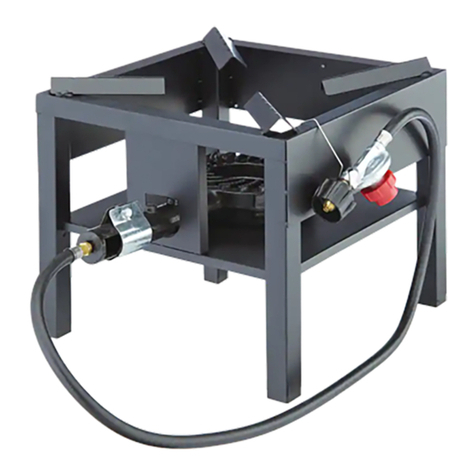
MasterChef
MasterChef 085-3259-6 SAFETY AND CARE MANUAL
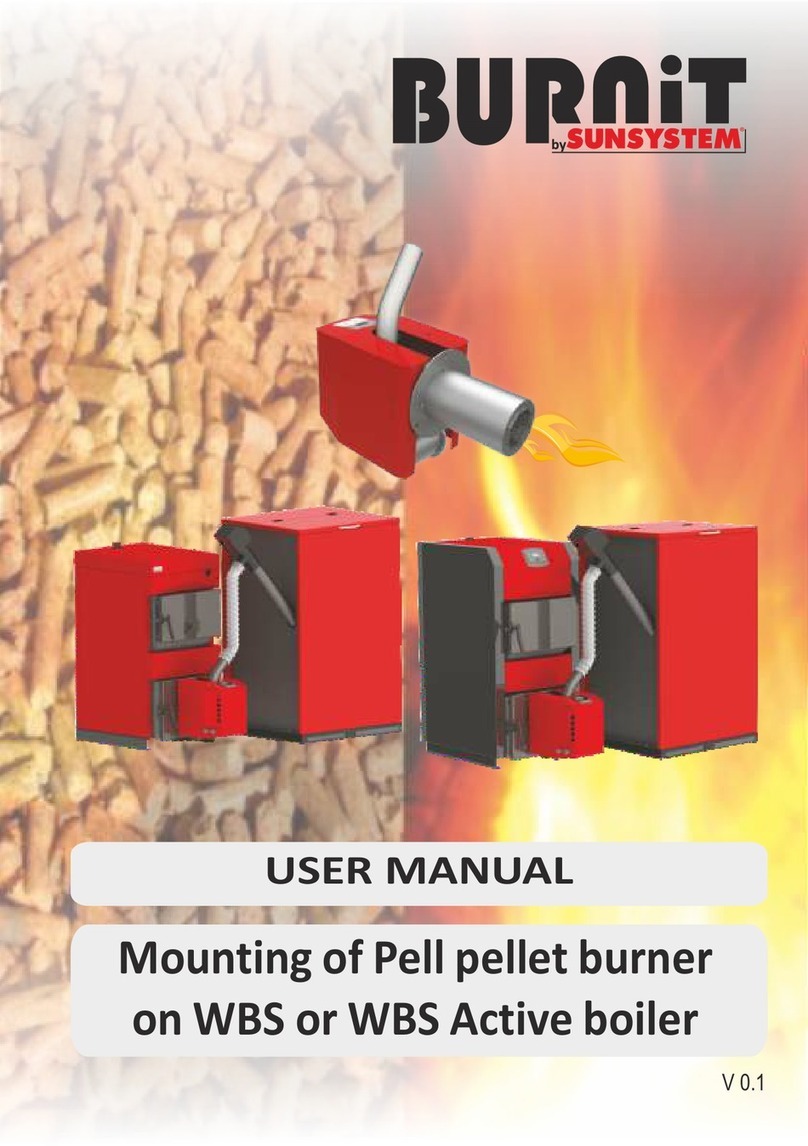
Sunsystem
Sunsystem Burnit user manual

Air Burners
Air Burners T300 operating manual
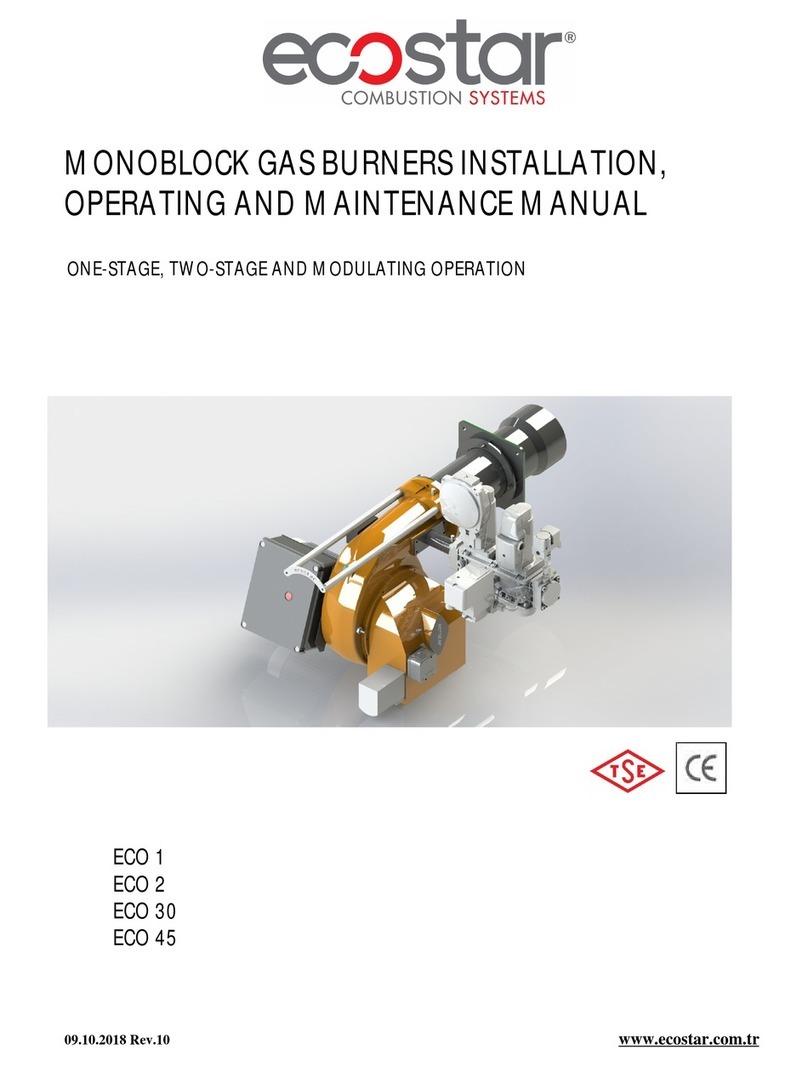
ECOSTAR
ECOSTAR ECO 1 Installation, operating and maintenance manual
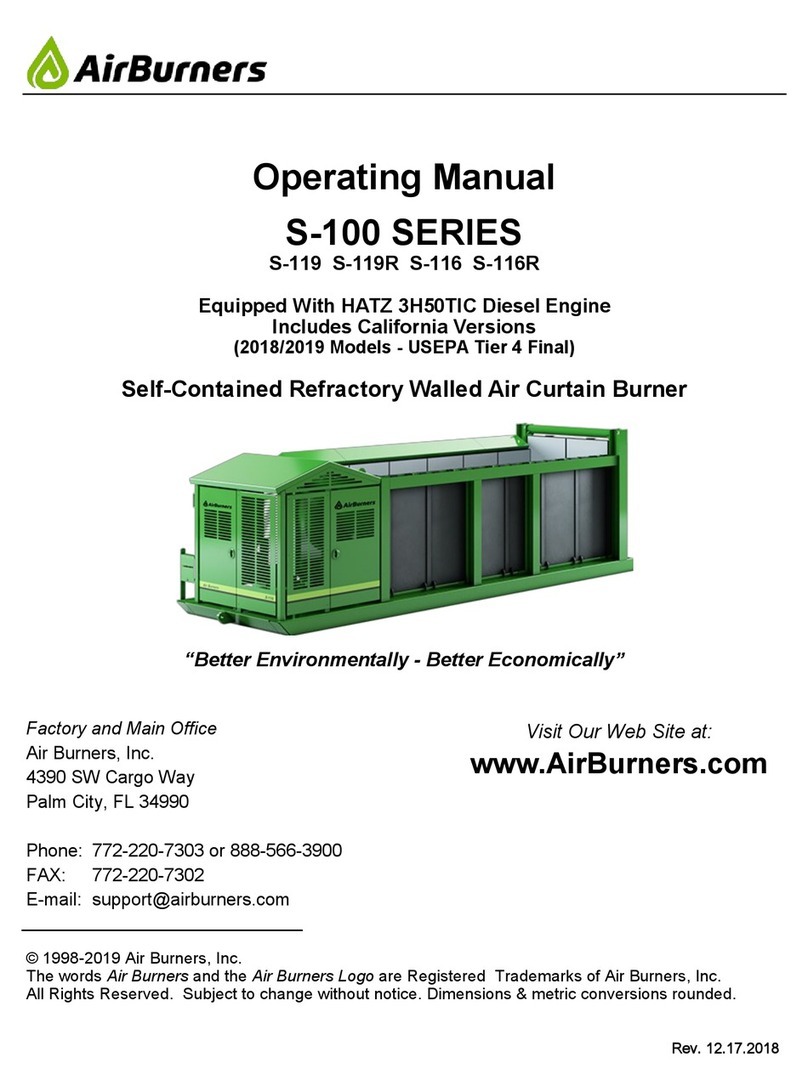
Air Burners
Air Burners S-100 SERIES operating manual
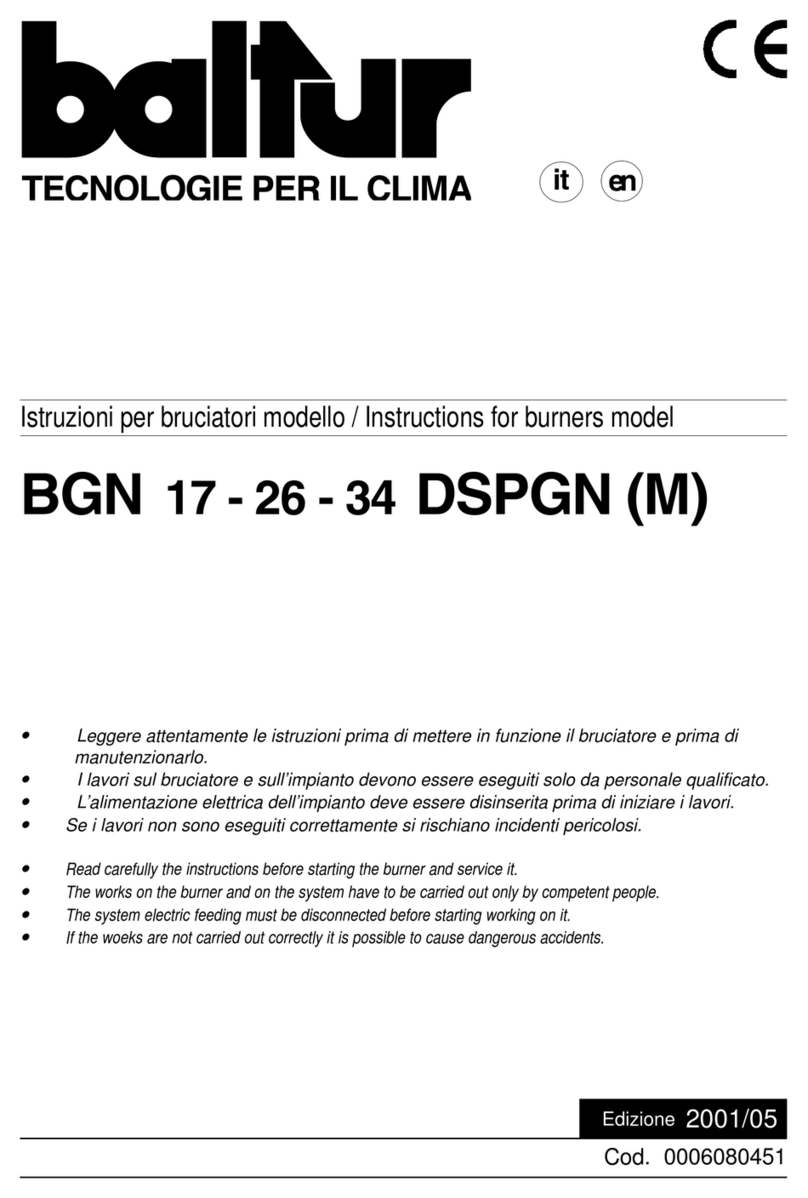
baltur
baltur BGN 17 DSPGN instructions
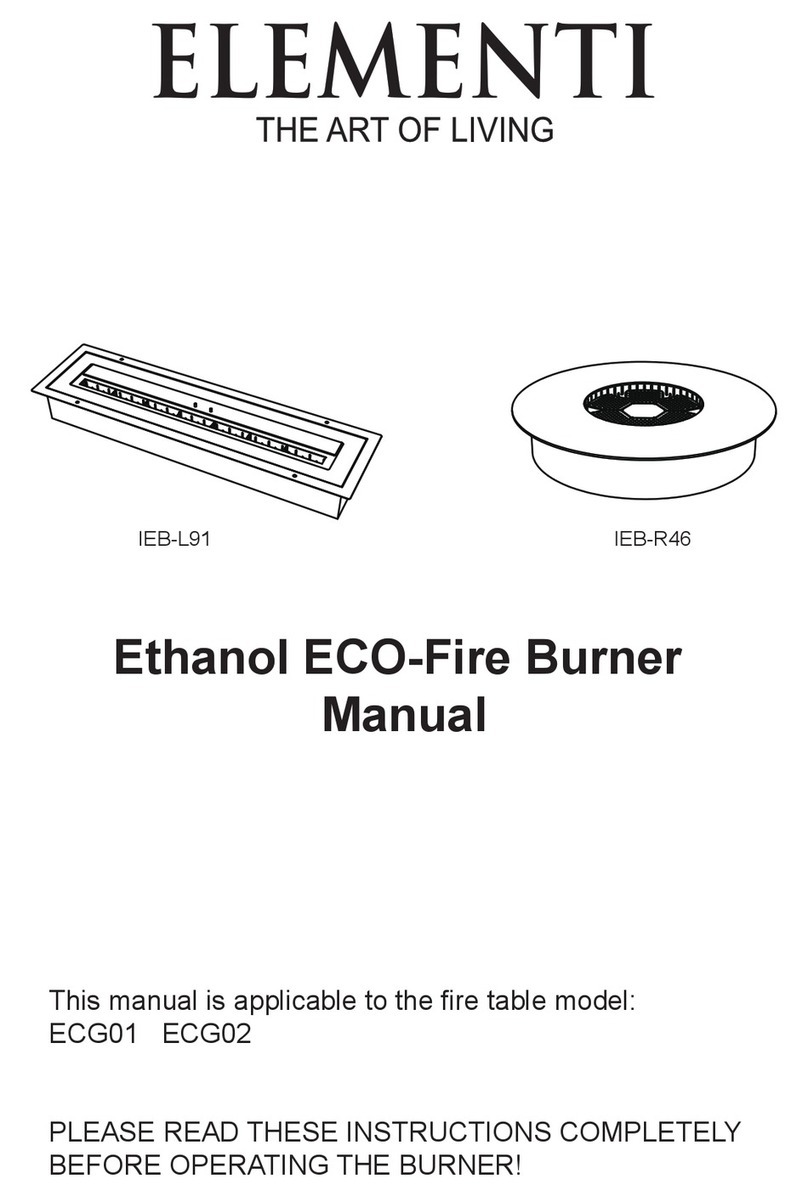
Element
Element IEB-L91 manual
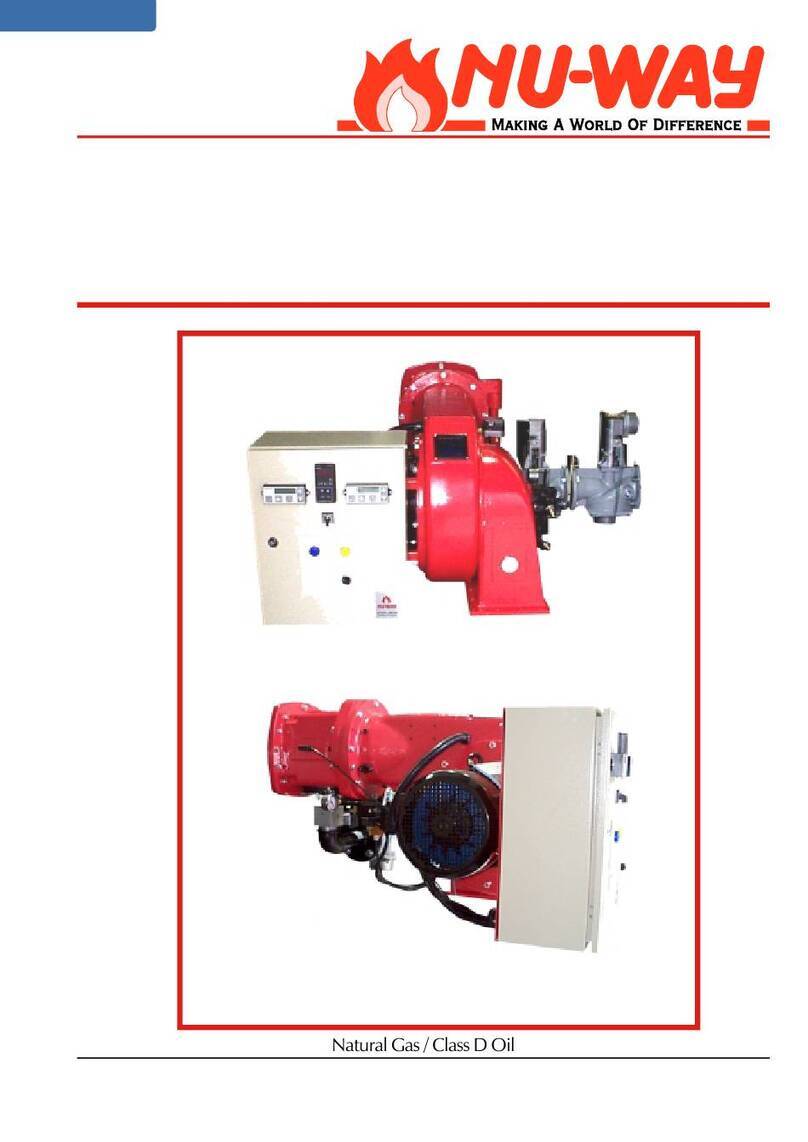
Nu-Way
Nu-Way NDFL100-38 Handbook
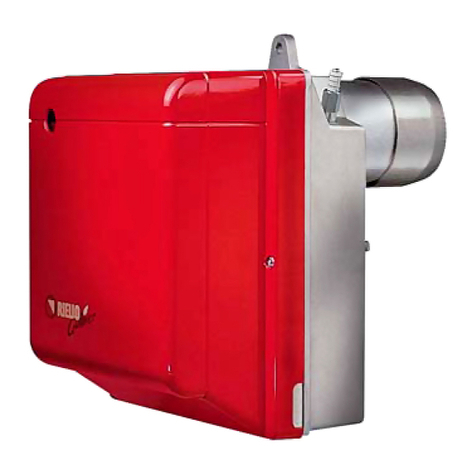
Riello Burners
Riello Burners Gulliver RG3D Installation, use and maintenance instructions

Riello Burners
Riello Burners Gulliver RG3 Installation, use and maintenance instructions
